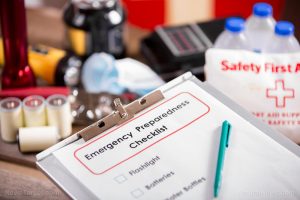Stockpile storage tips: How to organize your survival supplies
08/31/2021 / By Zoey Sky

As a prepper, your survival stockpile should be organized. This will make it easier to keep track of all your supplies so you can quickly restock when you run out of something.
If you’re at a loss because your homestead is cluttered and disorganized, start by clearing shelves and organizing everything. Always keep detailed records of your supplies before SHTF. (h/t to Survivopedia.com)
Why you need to store your survival supplies properly
Don’t let your hard-earned supplies and gear go to waste by leaving them strewn all over your house. When the power goes out, it’ll be easier to reach for a flashlight and extra batteries if you know where they are instead of rummaging in random drawers in the dark.
It’s also not wise to spend all your time accumulating supplies without sparing some for organizing your stockpile. You should keep a detailed record of all your gear and supplies, but that’s only possible if you start organizing immediately.
If you’re new to prepping, find an accessible room or area in your house that you can use to organize your supplies before you buy anything in bulk. This ensures that once you start stocking up on canned food, you’ll have a clean room that you can easily organize as you go along.
Since you’ll also be buying items that you won’t use daily or even once a week, you need a spare room to store your supplies in. This will help keep the space in your pantry or closet free for items that you’ll need to use regularly.
You can also use a corner in your garage or build shelves in your basement to store your gear and supplies. This will keep your supplies out of the way but still easily accessible if SHTF.
If you don’t have the extra space for your supplies, break your supplies into smaller groups and store them in designated places inside your home. For example, you can keep flashlights and extra batteries on the top shelf of a closet.
Storing gear in smaller groups also helps with security. If someone tries to steal your supplies, they won’t be able to take all of it. At the same time, storing gear in different locations ensures that you won’t lose your whole stockpile if your home is destroyed by a natural disaster.
Store items in hard, transparent plastic boxes for easy organization and identification. Most plastic boxes are also stackable, making it easier to move items around.

Start by reorganizing everything
If your supplies are strewn all over the house, set aside one weekend for organization and inventory checking. Take everything off the shelves and start organizing them.
Sort supplies into categories and decide which items to keep in your survival supply and which items should be stored elsewhere. When packing items, group similar things together. Store axes, hatches and pocket knives in one box so if you need something sharp for your survival bag, you’ll know where to search.
What to do with duplicate items
Preppers also stock up on certain duplicate items that serve different purposes. If you have some items like this, create specialized gear groups and store them in a specific area of your house. Some items, like those needed for an office survival kit, can also be used for your get-home bag.
Keep these extra supplies in a box that you can bring with you if you have to bug out. Store this box close to the front door so you can grab it on your way out.
Having a stockpile of duplicate gear will help give you peace of mind if you organize it properly since you have what you need in a specific place.
Group similar items together
After you place duplicate items in one container, don’t forget to store similar items together.
If you have a box for emergency lighting with flashlights and extra batteries in it, you can also keep your candles and matches in it. Keep blade sharpeners in the same container as your knives and other edged items. Leave a couple of can openers near your stock of canned food.
Storage ideas
Here are some suggestions on how to organize your supplies:
- Canned food dispensers – These dispensers will make it easier to rotate your supplies and prevent spoilage.
- Movable shelving units – Metal shelving units are durable and can hold heavy items.
- Sliding storage tower – Use these to store small cans and canisters by your fridge or anywhere with a couple of inches of free space.
- Small plastic bins – Small plastic bins are great if you live in a small apartment but want to prep. Use plastic storage bins and drawers to store smaller prepping supplies.
- Under the bed storage bin or slider – If there’s a bit of space under your bed, use bins or sliders to store more supplies under it.
Record everything properly
You also need to record everything, from the items you already have in stock, to expiration dates on perishable items. Start recording your supplies while you clear shelves for proper organization. Make your list practical and easy to understand.
Take note of the expiration dates of perishable items like food and medicine.

Keeping food records
Your food and water stockpile is essential to your survival, especially if you have to bug in during a long-term disaster scenario.
Since most foods will eventually spoil, you can’t keep them in storage forever. This is the main reason why you should practice the first in, first out (FIFO) storage system. Rotate your supplies properly and refer to your inventory so you know which items can still be used before they expire.
When buying new perishable items or food supplies, record their expiration dates. Write down when you bought the items and how long they will remain edible. (Related: Food storage tips: How to store canned foods safely.)
Use a flat shelf or plastic tote and keep it in your spare room for your stockpile. When storing items, place the items that will expire soon in front and those that will last longer at the back of the shelves. When you need something from your supply, get the ones in front.
Group all similar food items, like beverages, condiments or baking ingredients, together.
Updating your inventory regularly will help you save money since the FIFO storage method will ensure that you don’t have to buy more items because you forgot which canned items were going to expire soon.
Rotate perishable survival supplies
Rotating your supplies is also mandatory, and this also applies to supplies that aren’t edible.
Rotate extra batteries or gasoline so nothing goes to waste even if you don’t go through a survival scenario. Constantly rotating your perishable items means your stockpile can last indefinitely.
Keep your survival stockpile organized and rotate your supplies so nothing goes to waste. Staying organized will ensure that when SHTF, you can get what you need without wasting time looking for it.
Sources include:
Tagged Under: disaster, emergency food, Food storage, food supply, homesteading, off grid, planning, preparedness, prepper, prepping, prepping tips, SHTF, survival, survival food, survival supplies, Survival Tips, sustainable living
RECENT NEWS & ARTICLES
FoodStorage.News is a fact-based public education website published by Food Storage News Features, LLC.
All content copyright © 2018 by Food Storage News Features, LLC.
Contact Us with Tips or Corrections
All trademarks, registered trademarks and servicemarks mentioned on this site are the property of their respective owners.





















